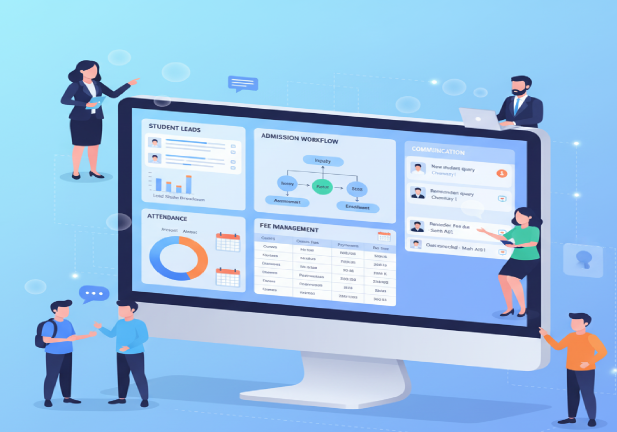The digital landscape of 2025 will be a colorful tapestry that is woven by threads of various operating platforms and devices. Companies that want to expand their reach and speedy development are increasingly relying on frameworks for app development that cross-platform. These powerful tools let programmers to create code in one go and then deploy it across different platforms, including iOS, Android, and the internet, thereby saving time, energy and providing an identical user experience.
The right framework but it is a crucial choice. The framework ecosystem is always evolving with new technology being developed and older ones becoming more mature. To navigate this confusing landscape, we dive into the most well-known frameworks for app development which are set to be the dominant by 2025. We provide an array of technical knowledge and practical advice.
1. React Native: Champion Continues to Rise
The idea was born out of the innovation labs within Meta (formerly Facebook), React Native has firmly established its position as a leader in the cross-platform realm. Utilizing the potential that comes from JavaScript and the well-known React library enables developers to build native-like mobile apps.
Deep Dive:
- JavaScript Powerhouse: The foundation of React Native is JavaScript One of the most widely used programming languages worldwide, gives the developers with a large pool and a vast ecosystem of tools and libraries. This drastically lowers the learning curve for web developers wishing to move into mobile application development.
- Native Modules and UI Components: Unlike web-based methods, React Native bridges the gap between native functions and. It lets developers use device features such as cameras, GPS, and sensors via native modules. Additionally, it makes use of Native UI components, creating applications that perform and feel identically to those developed with specific platforms SDKs.
- Hot Reloading and Fast Refresh These options dramatically speed up your development. Hot reloading lets developers observe changes to code immediately without having to rebuild the entire app as well as Fast Refresh provides even more secure updates, while keeping the state of the application in many instances. This feedback loop is continuous and improves the productivity of developers and speeds up debugging.
- Large and active Community The saga of maturity and the widespread acceptance of React Native have fostered a huge as well as active user base. This is evident in the readily accessible assistance, a wealth of documentation as well as a multitude of third-party libraries and an open-source ecosystem that is vibrant. The process of finding solutions to difficult issues and using existing components is a lot more simple.
- Performance considerations: Although React Native strives for native-like performance, complicated animated or computationally demanding tasks could still require optimization, or the use of native code specific to the platform. But for the majority of instances its performance is far superior to what you would expect.
- In the future, expect more advancements in React Natives performance, tools and integration with the latest technologies. The ongoing investment by Meta as well as the continuously active user community guarantee its viability and development over the next few years. If you are a business looking to create appealing mobile experiences quickly working with a trusted Mobile App development firm Dubai skilled with React Native remains a strategic option.
2. Flutter is Googles Bold and Beautiful Contender
Created through Google, Flutter has rapidly gained recognition for its aesthetically pleasing interface, outstanding performance and developer-friendly tools. It is based on Dart, the Dart programming language and provides an innovative method of development that is cross-platform.
Deep Dive:
- Dart and Skia Flutters base is based on its Dart programing language. This is a language that is known for its speed and efficiency, as well as its suitability to be used in UI development. Flutter also utilizes its Skia graphics engine that allows for smooth and precise rendering across various platforms, which ensures smooth and consistent animations.
- Widget-Based Architecture Flutters "everything is a widget" approach provides a customizable and flexible UI framework. Developers can create intricate user interfaces with an extensive set of widgets that are pre-built or even create custom widgets. This approach to declarative makes it easier to simplify UI development and encourages reuse of code.
- Hot Reload as well as Stateful Reload: Much like React Native, Flutter offers hot reloading for quick iteration. The stateful hot reload feature is a step higher by keeping the applications state after code changes, which makes the process of debugging and UI adjustments more effective.
- Outstanding Performance: The Flutters ahead of-time (AOT) compilation process to native code produces extremely efficient applications that frequently surpass its speed, responsiveness and performance of natively developed applications. Its Skia rendering engine is also a contributor to smooth transitions and animations.
- Growing Ecosystem: Although less well-known that React Native, Flutters ecosystem is expanding rapidly. Googles backing and active community contribute to an ever-growing number of tools, applications and resources.
- Beyond Mobile: Flutters features go beyond mobile, to the web as well as desktop (Windows, macOS, Linux) and embedded systems and embedded systems, making it a flexible cross-platform framework. Companies looking to create a single codebase for different platforms will be able to find Flutter to be a popular choice. For businesses in the growing industry of e-commerce An Ecommerce aap Development Company leveraging Flutter is able to provide visually attractive and highly-performing buying experiences on all platforms.
Real Also : Why U.S. Mobile Development Companies Are a Game-Changer for Startups in 2025
3. Microsofts Mature and Enterprise-focused Solution
Xamarin is which is now an integral part of the Microsoft .NET ecosystem is an established player in the development ecosystem that is cross-platform. It lets developers build applications with C# and the .NET framework.
Deep Dive:
- .NET as well as C# Advantage: Xamarin utilizes the sturdy and stable .NET framework as well as C#, the C# programming language, that are extensively used for enterprise development. This makes it an obvious option for companies already investing within Microsofts Microsoft ecosystem.
- Native UI Performance: Xamarin offers two primary methods: Xamarin.Forms for building shared UI across platforms, and Xamarin.Native for creating specific platforms-specific UIs that share business logic. Xamarin.Native delivers near-native performance as well as UI quality by using the native UI controls.
- A wide range of Native API access Xamarin offers a wide range of access to native APIs for each platform and features which allows developers to use the full potential of every operating system.
- Strong Enterprise Support As a product of Microsoft Xamarin, it has solid support for enterprises, robust tooling (like Visual Studio), and integration with other Microsoft technologies. That makes it an solid choice for large-scale, mission-critical applications.
- Code Reusability: Although Xamarin.Forms strives to maximize UI reuse of code, complicated or extremely customized UIs could still require specific adjustments for the platform. But that business logic layer could be shared extensively and result in significant reuse of code.
- The landscape is changing The evolution of .NET MAUI (Multi-platform App UI) that connects Xamarin.Forms as well as other .NET UI frameworks, Microsoft is streamlining its cross-platform offerings. Companies looking for a reliable and well-supported framework with solid enterprise capabilities frequently turn to Software Development Company Noida with experience in and around the .NET ecosystem, which includes Xamarin and the upcoming versions.
4. Ionic: Embracing Web Technologies for Mobile
Ionic adopts a unique approach by using familiar web technologies such as HTML, CSS, and JavaScript as well as frameworks such as Angular, React, or Vue.js to create hybrid mobile apps.
Deep Dive:
- Web-Based Design: The Ionics primary strength lies in its application of web technologies used in the standard web. This allows web developers to move fairly easily to mobile app development while using their current skills.
- Cordova/Capacitor Integration Ionic uses Cordova or Capacitor to connect to native device features through plugins. These bridges enable web applications to communicate with specific APIs for the platform.
- The Rich UI Component Library Ionic has a vast collection comprising pre-constructed UI components created to appear and feel natural across the two platforms, iOS as well as Android. These components are extremely customizable and speed up UI development.
- A Large Community and Resources: Based on the most popular technology for web, Ionic benefits from a large as well as active user base, extensive documentation as well as a wealth of resources available online.
- Performance considerations: Hybrid applications created using Ionic operate within the WebView that can cause performance problems when as compared to true native or React Native/Flutter-based applications in particular for UIs with complex designs or animations. However, the performance has drastically increased over time due to improvements in WebView technology as well as Ionics own improvements.
- Progressive Web Apps (PWAs): Ionic excels in the creation of PWAs that are web-based apps that are installed on the devices of users and provide a natural-looking experience. This expands the capabilities of the applications created with Ionic. Businesses looking to improve customer engagement and offer immediate assistance, integrating a high-end Chatbot development company along with an Ionic-based app is a great option.
Beyond the Big Four: Emerging Frameworks and considerations
Although React Native, Flutter, Ionic, and Xamarin Ionic are the main frameworks, others are also making a mark:
- NativeScript is an open-source framework to build native applications using JavaScript, TypeScript, or Angular.
- Compose Multiplatform Kotlins declarative UI framework that lets you share UI code across Android, iOS, desktop and web.
- Kivy is an open-source Python framework to develop multi-touch apps.
Selecting the right framework The Strategic Decision
What is the "best" Cross-platform Framework is dependent on the particular requirements of your project, which include:
- Performance requirements: Applications that have high-end graphics or complicated native capabilities could lean towards React Native, Flutter, or Xamarin.Native.
- UI complexity and flexibility: Flutters widget-based design as well as React Natives native UI components give you a wealth of choices for customizing.
- The development teams expertise Utilizing the web development experience of your team can make Ionic as well as React Native attractive. Teams that have .NET/Cexperience might prefer Xamarin.
- Budget and time-to-market Frameworks with robust tools and extensive component libraries can speed up development.
- Platform reach: Think about whether support for desktops and the web are essential, as provided by Flutter and, increasingly, by other.
Real also : How Much Do Software Developers Really Cost in 2025?
It is the future of cross-platform
As the need for fast and diverse mobile applications grows and cross-platform frameworks are expected to get more important. The advances in these technologies continue to blur the lines between cross-platform and native development, giving developers the tools for creating high-quality, effective, and entertaining applications that appeal to a wide audience. When you carefully evaluate the strengths and weaknesses of each framework enterprises can make informed choices and collaborate with the appropriate experts in development to navigate the multi-platform world with ease by the year 2025, and even beyond.











.jpg)
